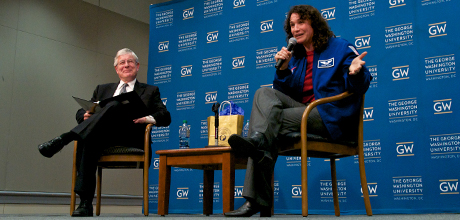By Laura Donnelly-Smith
In a candid conversation with students, faculty and community members, George Washington alumna and NASA astronaut Serena Auñón spoke about what NASA looks for in its astronaut corps, her concerns about the commercialization of space flight and why having a human presence in space is more important than ever before.
The event, called “How Do I Become a NASA Astronaut?” was held in the Marvin Center’s Continental Ballroom Monday evening. School of Engineering and Applied Science Dean David Dolling served as moderator of the discussion.
Dr. Auñón, B.S. ’97, is a member of NASA’s 20th astronaut class. Selected from a pool of more than 3,500 applicants, she spent nine months in Russia providing medical support to the crew members of the International Space Station. After earning a degree in electrical engineering at GW, Dr. Auñón attended medical school and became certified in internal and aerospace medicine, becoming a flight surgeon before joining the astronaut corps.
Her undergraduate education at GW was where it all started, she said. Her electrical engineering degree was an excellent preparation for medical school, and the SEAS curriculum—particularly the senior design course—taught her how to do rigorous independent work and to present it to diverse audiences, she told Dr. Dolling.
“That’s a very complimentary answer. I’d like to make it clear we didn’t discuss the questions ahead of time,” he said, as the audience chuckled.
People interested in working for NASA should absolutely focus on the science, technology, engineering and mathematics (STEM) fields, Dr. Auñón said. But beyond that, they should follow their interests.
“Do what you love,” she said. “People ask me, should I do this project or that one—what would NASA like? It doesn’t matter what NASA wants or likes. It’s what you want or like to do. This is your life’s work, and it should be your passion. It’s not worth it to you—or to NASA—if you don’t love what you’re doing.”
And when NASA makes its selections for astronauts, plenty beyond technical background comes into play, she said. In the age of the International Space Station, in which the average mission lasts six months, rather than the 16 days that was normal during the shuttle years, intangibles really matter.
“One of the biggest things they look for is, would I want to spend six months locked up in a tin can with this person?” she said. “The biggest things are humility, being pretty laid back and having a sense of humor. Training gets pretty rough at times, and if you don’t maintain a sense of humor, you won’t make it.”
Dr. Auñón also spoke about NASA’s partnership with private space companies, including SpaceX, Boeing and Sierra Nevada, all of which have funding to develop vehicles that will eventually shuttle Americans to the International Space Station. An audience member asked whether she is worried that these companies have profits as a bottom line.
“We’ve been flying for a long time. We’ve had mishaps and have lost people. Avoiding risk and finding a risk balance is really important to us,” she said. “We need to make sure our partners understand our requirements in keeping people safe. But you’re right—this is new territory. It’s exciting and scary to build a new vehicle. Because SpaceX, Boeing and Sierra Nevada are working with NASA hand in hand, we’ll have the best vehicle possible before putting any people on it. I think we have a good partnership.”
When people find out she’s an astronaut, a common response, Dr. Auñón said, is, “We still have a space program?” So she spends a lot of time educating people about NASA’s current priorities, which include conducting extremely diverse experiments aboard the International Space Station. Many of these experiments have the potential to yield valuable Earth applications, such as a device currently being tested that can take ordinary water and purify it to a degree that it can be used intravenously. That would be valuable aboard the ISS, of course, she said, but could also be vital to combat medics who don’t have access to IV solution in the field.
“We spent a lot of time building the International Space Station, and now it’s time for utilization,” she said. “That means we have time to perform scientific experiments—and there are literally hundreds—up there on orbit.”
Keeping people in space on a long-term basis working on projects that can benefit everyone is one of the greatest achievements of the ISS, Dr. Auñón said. “It’s an international partnership. Could you imagine 50 years ago that we’d be living in space with Russians, Canadians, Japanese, Europeans, all living together, all mission controls working together, to perform science? It’s hard to imagine but it happened. It’s our responsibility to continue to push to explore and inspire.”
In the end, a child in the audience voiced the question that every astronaut and millions of Americans watching shuttle launches have pondered: Is there a planet like Earth, and how do we get there?
“I hope there is a planet like Earth out there,” Dr. Auñón said. “I’d hate to think we’re alone here in the universe. With current chemical propulsion, it’ll take a long time” to find, she said. “I hope that you, the young budding engineer in the audience, will help us develop engines that get us there faster….The Hubble Space Telescope has taken pictures of hundreds of thousands of galaxies out there…I hope there’s another planet out there. I think I’m too old to be the one to find it. You might be the right age, though.”


